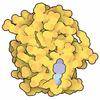[English] 日本語
 Yorodumi
Yorodumi- PDB-3mne: Crystal structure of the agonist form of mouse glucocorticoid rec... -
+ Open data
Open data
- Basic information
Basic information
| Entry | Database: PDB / ID: 3mne | ||||||
|---|---|---|---|---|---|---|---|
| Title | Crystal structure of the agonist form of mouse glucocorticoid receptor stabilized by F608S mutation at 1.96A | ||||||
 Components Components |
| ||||||
 Keywords Keywords | HORMONE RECEPTOR / protein-ligand complex / steroid nuclear receptor / mouse / agonist / co-activator | ||||||
| Function / homology |  Function and homology information Function and homology informationActivated PKN1 stimulates transcription of AR (androgen receptor) regulated genes KLK2 and KLK3 / SUMOylation of intracellular receptors / Recycling of bile acids and salts / Synthesis of bile acids and bile salts / Nuclear Receptor transcription pathway / Synthesis of bile acids and bile salts via 7alpha-hydroxycholesterol / Synthesis of bile acids and bile salts via 27-hydroxycholesterol / negative regulation of nuclear receptor-mediated glucocorticoid signaling pathway / HSP90 chaperone cycle for steroid hormone receptors (SHR) in the presence of ligand / Endogenous sterols ...Activated PKN1 stimulates transcription of AR (androgen receptor) regulated genes KLK2 and KLK3 / SUMOylation of intracellular receptors / Recycling of bile acids and salts / Synthesis of bile acids and bile salts / Nuclear Receptor transcription pathway / Synthesis of bile acids and bile salts via 7alpha-hydroxycholesterol / Synthesis of bile acids and bile salts via 27-hydroxycholesterol / negative regulation of nuclear receptor-mediated glucocorticoid signaling pathway / HSP90 chaperone cycle for steroid hormone receptors (SHR) in the presence of ligand / Endogenous sterols / HATs acetylate histones / nuclear receptor-mediated glucocorticoid signaling pathway / regulation of glucocorticoid biosynthetic process / nuclear glucocorticoid receptor activity / Regulation of lipid metabolism by PPARalpha / steroid hormone binding / Cytoprotection by HMOX1 / glucocorticoid metabolic process / response to cortisol / neuroinflammatory response / Estrogen-dependent gene expression / mammary gland duct morphogenesis / microglia differentiation / maternal behavior / astrocyte differentiation / adrenal gland development / RNA polymerase II intronic transcription regulatory region sequence-specific DNA binding / regulation of gluconeogenesis / locomotor rhythm / motor behavior / aryl hydrocarbon receptor binding / cellular response to Thyroglobulin triiodothyronine / regulation of lipid metabolic process / regulation of glucose metabolic process / cellular response to dexamethasone stimulus / cellular response to transforming growth factor beta stimulus / core promoter sequence-specific DNA binding / transcription regulator inhibitor activity / steroid binding / positive regulation of adipose tissue development / peroxisome proliferator activated receptor signaling pathway / regulation of cellular response to insulin stimulus / response to progesterone / TBP-class protein binding / nuclear receptor binding / negative regulation of smoothened signaling pathway / synaptic transmission, glutamatergic / promoter-specific chromatin binding / Hsp90 protein binding / circadian regulation of gene expression / mRNA transcription by RNA polymerase II / circadian rhythm / response to wounding / positive regulation of miRNA transcription / DNA-binding transcription repressor activity, RNA polymerase II-specific / RNA polymerase II transcription regulator complex / spindle / nuclear receptor activity / positive regulation of neuron apoptotic process / chromosome / chromatin organization / regulation of gene expression / DNA-binding transcription activator activity, RNA polymerase II-specific / transcription regulator complex / gene expression / sequence-specific DNA binding / RNA polymerase II-specific DNA-binding transcription factor binding / transcription coactivator activity / protein dimerization activity / nuclear speck / nuclear body / RNA polymerase II cis-regulatory region sequence-specific DNA binding / signaling receptor binding / protein domain specific binding / negative regulation of DNA-templated transcription / synapse / centrosome / chromatin binding / regulation of DNA-templated transcription / protein kinase binding / negative regulation of transcription by RNA polymerase II / positive regulation of transcription by RNA polymerase II / protein-containing complex / mitochondrion / DNA binding / zinc ion binding / nucleoplasm / identical protein binding / nucleus / membrane / cytoplasm / cytosol Similarity search - Function | ||||||
| Biological species |  | ||||||
| Method |  X-RAY DIFFRACTION / X-RAY DIFFRACTION /  SYNCHROTRON / SYNCHROTRON /  MOLECULAR REPLACEMENT / Resolution: 1.96 Å MOLECULAR REPLACEMENT / Resolution: 1.96 Å | ||||||
 Authors Authors | Schoch, G.A. / Seitz, T. / Benz, J. / Banner, D. / Stihle, M. / D'Arcy, B. / Thoma, R. / Sterner, R. / Hennig, M. / Ruf, A. | ||||||
 Citation Citation |  Journal: J.Mol.Biol. / Year: 2010 Journal: J.Mol.Biol. / Year: 2010Title: Enhancing the stability and solubility of the glucocorticoid receptor ligand-binding domain by high-throughput library screening. Authors: Seitz, T. / Thoma, R. / Schoch, G.A. / Stihle, M. / Benz, J. / D'Arcy, B. / Wiget, A. / Ruf, A. / Hennig, M. / Sterner, R. | ||||||
| History |
|
- Structure visualization
Structure visualization
| Structure viewer | Molecule:  Molmil Molmil Jmol/JSmol Jmol/JSmol |
|---|
- Downloads & links
Downloads & links
- Download
Download
| PDBx/mmCIF format |  3mne.cif.gz 3mne.cif.gz | 76.8 KB | Display |  PDBx/mmCIF format PDBx/mmCIF format |
|---|---|---|---|---|
| PDB format |  pdb3mne.ent.gz pdb3mne.ent.gz | 56.1 KB | Display |  PDB format PDB format |
| PDBx/mmJSON format |  3mne.json.gz 3mne.json.gz | Tree view |  PDBx/mmJSON format PDBx/mmJSON format | |
| Others |  Other downloads Other downloads |
-Validation report
| Summary document |  3mne_validation.pdf.gz 3mne_validation.pdf.gz | 812 KB | Display |  wwPDB validaton report wwPDB validaton report |
|---|---|---|---|---|
| Full document |  3mne_full_validation.pdf.gz 3mne_full_validation.pdf.gz | 822.5 KB | Display | |
| Data in XML |  3mne_validation.xml.gz 3mne_validation.xml.gz | 17.4 KB | Display | |
| Data in CIF |  3mne_validation.cif.gz 3mne_validation.cif.gz | 24.8 KB | Display | |
| Arichive directory |  https://data.pdbj.org/pub/pdb/validation_reports/mn/3mne https://data.pdbj.org/pub/pdb/validation_reports/mn/3mne ftp://data.pdbj.org/pub/pdb/validation_reports/mn/3mne ftp://data.pdbj.org/pub/pdb/validation_reports/mn/3mne | HTTPS FTP |
-Related structure data
| Related structure data | 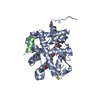 3mnoC 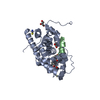 3mnpC  1m2zS S: Starting model for refinement C: citing same article ( |
|---|---|
| Similar structure data |
- Links
Links
- Assembly
Assembly
| Deposited unit | 
| ||||||||
|---|---|---|---|---|---|---|---|---|---|
| 1 |
| ||||||||
| Unit cell |
|
- Components
Components
| #1: Protein | Mass: 30096.092 Da / Num. of mol.: 1 / Fragment: UNP residues 527-783 / Mutation: F608S Source method: isolated from a genetically manipulated source Source: (gene. exp.)   | ||||
|---|---|---|---|---|---|
| #2: Protein/peptide | Mass: 1593.844 Da / Num. of mol.: 1 / Fragment: TIF2 coactivator motif, residues 740-752 / Source method: obtained synthetically Details: The sequence occurs naturally in Mus musculus (mouse) References: UniProt: Q61026 | ||||
| #3: Chemical | | #4: Chemical | ChemComp-DEX / | #5: Water | ChemComp-HOH / | |
-Experimental details
-Experiment
| Experiment | Method:  X-RAY DIFFRACTION / Number of used crystals: 1 X-RAY DIFFRACTION / Number of used crystals: 1 |
|---|
- Sample preparation
Sample preparation
| Crystal | Density Matthews: 3.05 Å3/Da / Density % sol: 59.67 % |
|---|---|
| Crystal grow | Method: vapor diffusion, sitting drop / pH: 7 Details: 0.5 M ammonium sulfate, 0.9 M sodium tartrate, 0.1 M PIPES pH 7.0, VAPOR DIFFUSION, SITTING DROP |
-Data collection
| Diffraction | Mean temperature: 100 K |
|---|---|
| Diffraction source | Source:  SYNCHROTRON / Site: SYNCHROTRON / Site:  SLS SLS  / Beamline: X10SA / Wavelength: 0.7 Å / Beamline: X10SA / Wavelength: 0.7 Å |
| Detector | Date: Jul 7, 2008 |
| Radiation | Protocol: SINGLE WAVELENGTH / Monochromatic (M) / Laue (L): M / Scattering type: x-ray |
| Radiation wavelength | Wavelength: 0.7 Å / Relative weight: 1 |
| Reflection | Resolution: 1.96→12.9 Å / Num. all: 26835 / Num. obs: 26835 / % possible obs: 99.7 % / Redundancy: 11.22 % / Biso Wilson estimate: 26.87 Å2 / Rsym value: 0.051 / Net I/σ(I): 15.72 |
| Reflection shell | Resolution: 1.96→2.06 Å / Redundancy: 9.18 % / Mean I/σ(I) obs: 2.41 / Num. unique all: 3555 / Rsym value: 0.4566 |
- Processing
Processing
| Software |
| ||||||||||||||||||||||||||||||||||||||||||||||||||
|---|---|---|---|---|---|---|---|---|---|---|---|---|---|---|---|---|---|---|---|---|---|---|---|---|---|---|---|---|---|---|---|---|---|---|---|---|---|---|---|---|---|---|---|---|---|---|---|---|---|---|---|
| Refinement | Method to determine structure:  MOLECULAR REPLACEMENT MOLECULAR REPLACEMENTStarting model: 1M2Z Resolution: 1.96→12.98 Å / Cross valid method: THROUGHOUT / σ(F): 0
| ||||||||||||||||||||||||||||||||||||||||||||||||||
| Displacement parameters | Biso mean: 33.3 Å2
| ||||||||||||||||||||||||||||||||||||||||||||||||||
| Refine analyze | Luzzati coordinate error obs: 0.1776 Å | ||||||||||||||||||||||||||||||||||||||||||||||||||
| Refinement step | Cycle: LAST / Resolution: 1.96→12.98 Å
| ||||||||||||||||||||||||||||||||||||||||||||||||||
| Refine LS restraints |
| ||||||||||||||||||||||||||||||||||||||||||||||||||
| LS refinement shell | Resolution: 1.96→2.08 Å / Total num. of bins used: 9
|
 Movie
Movie Controller
Controller




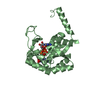

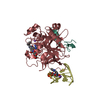

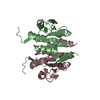



 PDBj
PDBj




